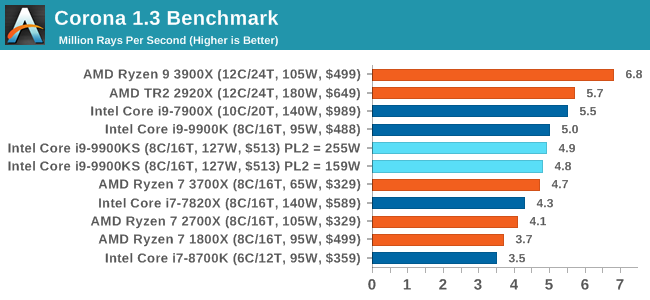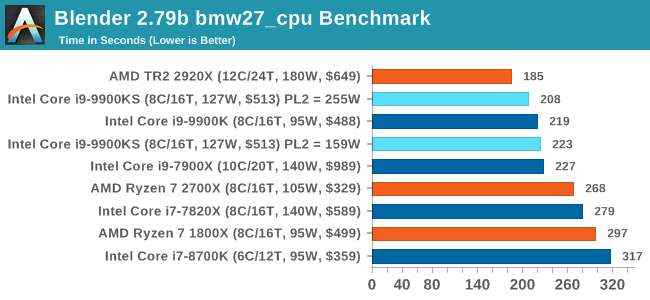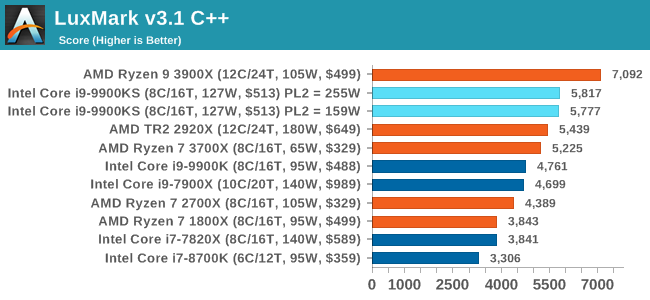The Intel Core i9-9900KS Review: The 5 GHz Consumer Special
by Dr. Ian Cutress on October 31, 2019 10:45 AM ESTCPU Performance: Rendering Tests
Rendering is often a key target for processor workloads, lending itself to a professional environment. It comes in different formats as well, from 3D rendering through rasterization, such as games, or by ray tracing, and invokes the ability of the software to manage meshes, textures, collisions, aliasing, physics (in animations), and discarding unnecessary work. Most renderers offer CPU code paths, while a few use GPUs and select environments use FPGAs or dedicated ASICs. For big studios however, CPUs are still the hardware of choice.
All of our benchmark results can also be found in our benchmark engine, Bench.
Corona 1.3: Performance Render
An advanced performance based renderer for software such as 3ds Max and Cinema 4D, the Corona benchmark renders a generated scene as a standard under its 1.3 software version. Normally the GUI implementation of the benchmark shows the scene being built, and allows the user to upload the result as a ‘time to complete’.
We got in contact with the developer who gave us a command line version of the benchmark that does a direct output of results. Rather than reporting time, we report the average number of rays per second across six runs, as the performance scaling of a result per unit time is typically visually easier to understand.
The Corona benchmark website can be found at https://corona-renderer.com/benchmark

Interestingly both 9900KS settings performed slightly worse than the 9900K here, which you wouldn't expect given the all-core turbo being higher. It would appear that there is something else the bottleneck in this test.
Blender 2.79b: 3D Creation Suite
A high profile rendering tool, Blender is open-source allowing for massive amounts of configurability, and is used by a number of high-profile animation studios worldwide. The organization recently released a Blender benchmark package, a couple of weeks after we had narrowed our Blender test for our new suite, however their test can take over an hour. For our results, we run one of the sub-tests in that suite through the command line - a standard ‘bmw27’ scene in CPU only mode, and measure the time to complete the render.
Blender can be downloaded at https://www.blender.org/download/

All the 9900 parts and settings perform roughly the same with one another, however the PL2 255W setting on the 9900KS does allow it to get a small ~5% advantage over the standard 9900K.
LuxMark v3.1: LuxRender via Different Code Paths
As stated at the top, there are many different ways to process rendering data: CPU, GPU, Accelerator, and others. On top of that, there are many frameworks and APIs in which to program, depending on how the software will be used. LuxMark, a benchmark developed using the LuxRender engine, offers several different scenes and APIs.
In our test, we run the simple ‘Ball’ scene on both the C++ and OpenCL code paths, but in CPU mode. This scene starts with a rough render and slowly improves the quality over two minutes, giving a final result in what is essentially an average ‘kilorays per second’.

Both 9900KS settings perform equally well here, and a sizeable jump over the standard 9900K.
POV-Ray 3.7.1: Ray Tracing
The Persistence of Vision ray tracing engine is another well-known benchmarking tool, which was in a state of relative hibernation until AMD released its Zen processors, to which suddenly both Intel and AMD were submitting code to the main branch of the open source project. For our test, we use the built-in benchmark for all-cores, called from the command line.
POV-Ray can be downloaded from http://www.povray.org/

One of the biggest differences between the two power settings is in POV-Ray, with a marked frequency difference. In fact, the 159W setting on the 9900KS puts it below our standard settings for the 9900K, which likely had an big default turbo budget on the board it was on at the time.











235 Comments
View All Comments
Galid - Friday, November 1, 2019 - link
A little mistake on my part, it was my AMD Athlon 64 3200+ and not the x2. The worst about this problem was that the chipset (nForce3-250 or something like that) was made by Nvidia and it had problems with their video cards only.I forgot to mention that we bought a new system for my brother because the CPU died, I think that's the only cpu that ever died on me and it was an i5-2500k. The most shocking about that is I overclocked mine to 4.7ghz for all these years and it's still going strong(hence the reason I'm still waiting to upgrade). He bought some closed loop water cooling and never overclocked the cpu still it died on him... shame.
alufan - Wednesday, November 6, 2019 - link
hmm so intel has better quality etc lets consider for a moment all the security issues with intel, then lets look at the way they refused to develop the cpu until AMD came alont with 12, then 12+ then 7 and shortly 7+ meanwhile intel cannot make a decent 10nm chip speaks volumes about your argument, then lets look at the TDP the AMD chip at 65w is almost neck and neck with the intel one at 255w !Only cpu i ever had fail was a core 2 duo never lost a GPU from either camp but guess what... the intel GPU is being design led by a former AMD/ATI staffer as is the new intel CPU as well, think we can leave it there
outsideloop - Friday, November 1, 2019 - link
If you want stream your game while paying, get the 3900X.outsideloop - Friday, November 1, 2019 - link
While playing...flyingpants265 - Monday, November 4, 2019 - link
No more of the weird streaming comments please. Nobody really streams.BikeDude - Wednesday, November 6, 2019 - link
<blockquote>more mature product</blockquote>But all reports so far indicates that Intel has been hit much harder by spectre-class bugs?
"All the issues that came out this year, were reported not to be an issue on AMD" (https://www.theregister.co.uk/2019/10/29/intel_dis...
Midwayman - Thursday, October 31, 2019 - link
Curious you think that someone considering a 9900KS is a 'budget' gamer. You could easily make that argument with any high end component. I'd expect them to be pairing this with both a 2080ti and a high refresh monitor.evernessince - Friday, November 1, 2019 - link
I think you are mistaking enthusiast for "fool". I've bought a 980 Ti and a 1080 Ti but I sure as hell ain't going to buy a 2080 Ti. I had a 5820K and bought a 3700X.Thankfully, there are some of us with some fiscal responsibility.
Spunjji - Friday, November 1, 2019 - link
Cheers for doing your bit to reign in the madness.Death666Angel - Saturday, November 2, 2019 - link
And to add to that, I can easily fit a high end 200W+ TDP CPU cooler in my small mATX case, but I cannot fit a graphics card that is longer than 26 cm (23.5 cm after my front fan modifications) into my case. SFF systems are more limited by graphics card size than cooler size most of the time. And the best cards in a smaller form factor are 1080 TI and 2070 Super as far as I know.